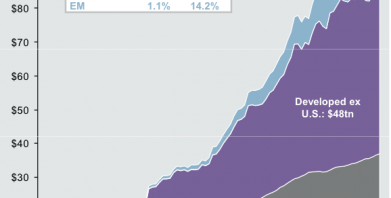As you know, I’ve been calling for a bond market crisis for months now. That crisis has officially begun in Greece, and will be spreading in the coming months. Currently it’s focused in countries that cannot print their own currencies (the PIIGS in Europe, particularly Greece).
However, China and Japan are also showing signs of trouble and ultimately the bond crisis will be coming to the US’s shores.
However, it’s critical to note that crises do not unfold all at once. The Tech Bubble, for instance, which was both obvious and isolated to a single asset class, took over two years to unfold.
As terrible as the bust was, that crisis was relatively small as far as the damage. At its peak, the market capitalization of the Tech Bubble was less than $15 trillion. Moreover, it was largely isolated to stocks and no other asset classes.
By way of contrast, the bond bubble is now well over $199 trillion in size. And if we were to include credit instruments that trade based on bonds, we’re well north of $600 trillion.
Not only is this exponentially larger than global GDP (~$80 trillion), but because of the structure of the banking system the implications of this bubble are truly systemic in nature.
Modern financial theory dictates that sovereign bonds are the most “risk free” assets in the financial system (equity, municipal bond, corporate bonds, and the like are all below sovereign bonds in terms of risk profile).
The reason for this is because it is far more likely for a company to go belly up than a country.
Because of this, the entire Western financial system has sovereign bonds (US Treasuries, German Bunds, Japanese sovereign bonds, etc.) as the senior most asset on bank balance sheets.
Because banking today operates under a fractional system, banks control the amount of currency in circulation by lending money into the economy and financial system.
These loans can be simple such as mortgages or car loans… or they can be much more complicated such as deriviative hedges (technically these would not be classified as “loans” but because they represent leverage in the system, I’m categorizing them as such).
Bonds, specifically sovereign bonds, are the assets backing all of this.
And because of the changes to leverage requierments implemented in 2004, (thanks to Wall Street lobbying the SEC), every $1 million in sovereign bonds in the system is likely backstopping well over $20 (and possibly even $50) million in derivatives or off balance sheet structured investment vehicles.
Globally, the sovereign bond market is $58 trillion in size.
The investment grade sovereign bond market (meaning sovereign bonds for countries with credit ratings above BBB) is around $53 trillion. And if you’re talking about countries with credit ratings of A or higher, it’s only $43 trillion.
This is the ultimate backstop for over $700 trillion in derivatives. And a whopping $555 trillion of that trades based on interest rates (bond yields).
The significance of these developments cannot be overstated. The financial system today is even more leveraged than it was in 2008. The US alone has 30% more debt in the financial system… and even less bonds backstopping it because of the Fed’s QE programs.
A new crisis is approaching. Smart investors are preparing now, BEFORE it hits.
If you’ve yet to take action to prepare for this, we offer a FREE investment report called the Financial Crisis “Round Two” Survival Guide that outlines simple, easy to follow strategies you can use to not only protect your portfolio from it, but actually produce profits.
We made 1,000 copies available for FREE the general public.
As we write this, there are less than 15 left.
To pick up yours, swing by….
http://www.phoenixcapitalmarketing.com/roundtwo.html
Best Regards
Phoenix Capital Research
Our FREE e-letter: www.gainspainscapital.com





